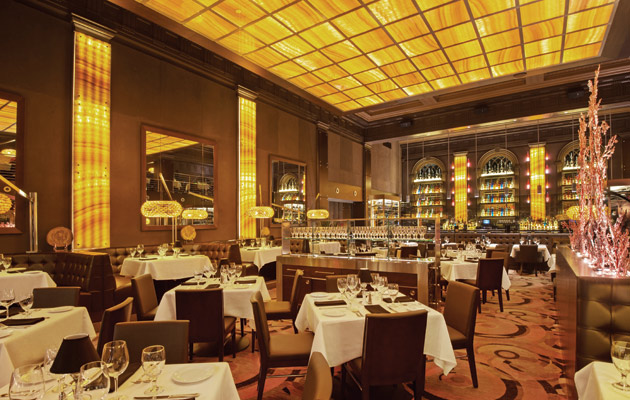Inventive Ventilation
In the ever-innovative arena of restaurant operation, certain trends pose their own singular requirements when it comes to air management.
The growing popularity of the cigar bar and restaurant combination represents one case in point. The building that houses Leaf Cigar Bar and Famous Smoke Shop is 60,000 square feet. A warehouse and humidor take up the bulk, at 40,000 square feet, while the cigar store and restaurant/bar together comprise approximately 5,000 square feet with 96 seats.
The bar is a large, open room with tall ceilings. "The larger room volume allows the smoke to drift up naturally where it is captured in the return air stream and removed from the space," says Renzetti.
Leaf's air-management system was developed by Jim Eck, LEED AP, president of Quadratus Construction Management. The building's rooftop units use HEPA filters with charcoal filters to remove particulates and odors; an energy recovery wheel recaptures some of the heating or cooling energy. Because of the volume of cigar smoke, the system requires more maintenance than a normal restaurant or bar, says Renzetti, with constant cleaning and filter replacement.
Additionally, beyond sophisticated mechanicals the cigar bar's decor takes odor management and air quality into account. It utilizes a lot of hard surfaces that staff can easily wipe down and clean every night. Outside of the napkins, the space contains no table linens that could pick up the scent of smoke, and the seats feature wood and leather construction. "You don't want a fabric curtain or chair covering because that will trap cigar odors," Renzetti says.
Open Air
Open or demonstration kitchens also pose obvious airflow problems and potential odor problems because a busy production center is exposed to the dining room. "Some of our higher-end Ocean Prime restaurants have open kitchens," says Cameron Mitchell's Waller, who admits that air balancing can be a challenge in that format. "Much depends upon the design, how open the kitchen is."
Various solutions here include tighter tolerances in the distance between cooking equipment and exhaust hoods, and placement of makeup air vents around the kitchen space.
Even without an open kitchen, doors and windows that constantly open during service periods can disrupt airflow, letting conditioned air out and unconditioned air in. Many Applebee's restaurants offer Carside To Go service, where customers can place an order in advance and pull their vehicles up to collect their food. "That door at the other end of the building is opened and closed often, depending upon the volume of business," O'Keefe says. "If the front door is open at the same time, then you have airflow, a wind from one door to the other." The solution, he says, is to keep those doors as far apart as possible, with baffles in between. The difficulty is that both doors usually need access to the kitchen, he adds, but "a good designer is aware of the situation and takes it into consideration."
Reinforcements
Restaurant operators can choose among many helpful ancillary tools available to help manage restaurant air quality. Door closers, for one, can alleviate the situation cited above.
Air and plastic strip curtains at walk-ins and loading docks, Chandler adds, help keep conditioned air in and unconditioned air out, in addition to barring insects and rodents. At the front door, vestibules provide an intermediate airlock, he says, so prevailing winds don't overpower the positive pressure in the dining room.
Ceiling fans not only act as a design element, but also help eliminate dead-air spaces. "Fans look good; customers love looking at them. The air movement helps area climate control," Waller says. He also recommends window blinds to shade solar heat.
Some operations also use fans on patios, occasionally in concert with misters to add humidity. Heaters represent a more effective option in mild climates to extend the seasonal use of patios, says O'Keefe. But restaurant operators should take into consideration prevailing and gusty winds. "Generally, we like to orient spaces on the south side to get the best exposure."
"West-facing exteriors with large window exposures will, of course, have larger cooling loads," adds Chandler. Strategically planted shade trees help offset afternoon solar load peaks.
Eternal Vigilance Pays Off
All those doors banging open and shut, fans twirling and exhausting, customers coming in and out, grills grilling, and fryers frying constantly tax restaurants' dynamic indoor air systems, making constant vigilance the watchword.
"People forget that air balance is not a one-time thing. You don't just open the restaurant and forget about it," advises Waller. "Aspects constantly change; exhaust ducts get dirty, new belts wear, fans slow down or speed up."
That's why developing an air-quality maintenance program is critical. It should include scheduled replacement of HVAC air filters, service checks of all equipment, including monitoring
refrigerant charge and cleaning of grease exhaust systems, Chandler says.
O'Keefe agrees and adds the plan should include regular preventive maintenance of all rooftop units. Unique climates make this especially important. "If you are located near an ocean, for example, the briny air is corrosive to refrigeration coils," he warns. Units with coated coils protect against sea salt.
"Every other year we do an air-balance test in every restaurant, bring in a specialist to check CFMs, the draws and returns, and then compare that to the original design specs," says Waller.
"It's a dynamic system, and it's important to have maintenance professionals involved," believes Tepen. Most restaurant managers are too busy to effectively supervise HVAC maintenance. "Replacement of rooftop units is expensive and you want to get the most life you can out of them. Without proper oversight things can get messed up badly really fast."
Things can also get dangerous. A restaurant's safety web also includes well-maintained air-management systems. "If hood canopies, ducts and vents are not cleaned regularly of grease, that's a fire hazard," cautions Tepen.
Although air management could be considered just part of the mechanical support systems, it should be an integral part of the architectural design process because of its importance to a restaurant's success. "Just spend a little bit more on your infrastructure, and it will pay itself back in ways you cannot directly measure," urges Chandler. "Customers will enjoy their food more if they are comfortable in the dining room; and you'll keep the cookstaff longer than if it's miserably hot in the kitchen."



